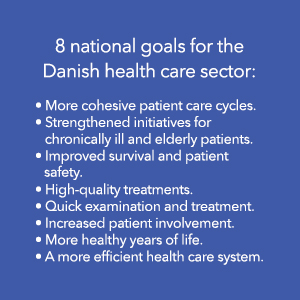 The use of antibiotics is growing rapidly. Excessive or inappropriate prescriptions of antibiotics and lack of follow-up on treatments results in antimicrobial resistance. The antimicrobials become resistant, and therefore they do not act on antibiotics as expected. This makes treatment ineffective, and already now 20-50 percent of all antibiotic prescriptions are expected to be useless. The fear is that in the future, this might become one of the world’s most pressing public health threats.
The use of antibiotics is growing rapidly. Excessive or inappropriate prescriptions of antibiotics and lack of follow-up on treatments results in antimicrobial resistance. The antimicrobials become resistant, and therefore they do not act on antibiotics as expected. This makes treatment ineffective, and already now 20-50 percent of all antibiotic prescriptions are expected to be useless. The fear is that in the future, this might become one of the world’s most pressing public health threats.
We need to change this negative development curve, and therefore leaders in the health care sector must act now.
If we become better at using antibiotics in a rational way, with the purpose to reduce antimicrobial resistance, and if we become aware of excessive or inappropriate prescription of antibiotics, we can slow down the inappropriate development of the antimicrobial resistance curve. At SAS, we have looked into this specific challenge, and we now know that advanced analytics is one key to get in control.
If we become aware of excessive or inappropriate prescription of antibiotics, we can slow down the inappropriate development of the antimicrobial resistance curve. Advanced analytics is one key to get in control.
This is exactly what the Danish government is doing with its action plan published in July 2017. The plan, National action plan for antibiotics for human beings, presents three primary goals to be met in Denmark by 2020. Similar national plans exist in Norway and Sweden.
I like these plans because they are both visionary and very operational, and because they focus on changing bad habits to save lives. If we do not change, we will all be at risk in the future of dying from simple infections because we will not respond to simple antibiotics.
 By working towards reaching the new goals, hospitals in Denmark will, at the same time, get closer to living up to a great part of the eight Danish national goals for the health care sector. The eight Danish national goals are described in our health care report Data driven management in health care.
By working towards reaching the new goals, hospitals in Denmark will, at the same time, get closer to living up to a great part of the eight Danish national goals for the health care sector. The eight Danish national goals are described in our health care report Data driven management in health care.
As I see it, hospitals must work towards these new measured targets to resist further development of antibiotic resistance. If they do, this will lead to higher survival rates, better patient safety, treatment of high quality, fast diagnosis, fast treatment and a more efficient health care sector. This means that hospitals will also meet at least four of the important national health care goals.
At SAS we work daily with predictive data and surveillance, and our solutions help patients worldwide achieve better health by analysing data with advanced tools. Strategies and tools we have been using for decades can also help reduce excessive or inappropriate prescription of antibiotics.
Our systems can control and overview all patient data in the right setting and point out the weak spots. It sounds easy, but this is new knowledge dragged out from big data in a way no health care professional could have done, despite educational and practical skills.
Already now 20-50% of all antibiotic prescriptions are expected to be useless. We need to stop this development. #analytics #healthcare Click To TweetBut how can access to data and analytics help solve such a big problem?
There are three keywords to answer that question: control, overview and follow-up. We have combined these concepts in our SAS® solution for antibiotic stewardship. It offers control, overview and follow-up on every patient in antibiotic treatment by using data to support clinical decisions. This means the solution supports health care professionals to work in a rational way with antibiotics. It also provides health care professionals and managers with a common tool.
In two weeks you can read my next article on Hidden Insights, and learn more about what we can achieve with our new antibiotic stewardship solution.
For more information or a presentation of the antibiotic stewardship solution, please contact Morten Krogh Danielsen.
